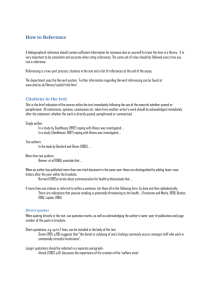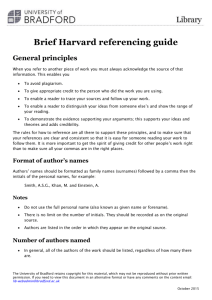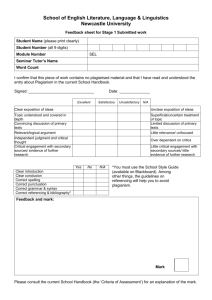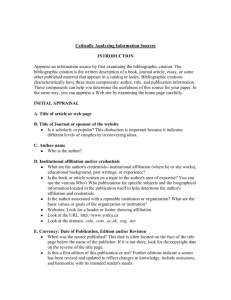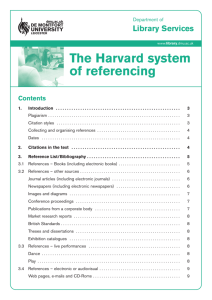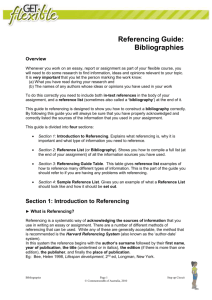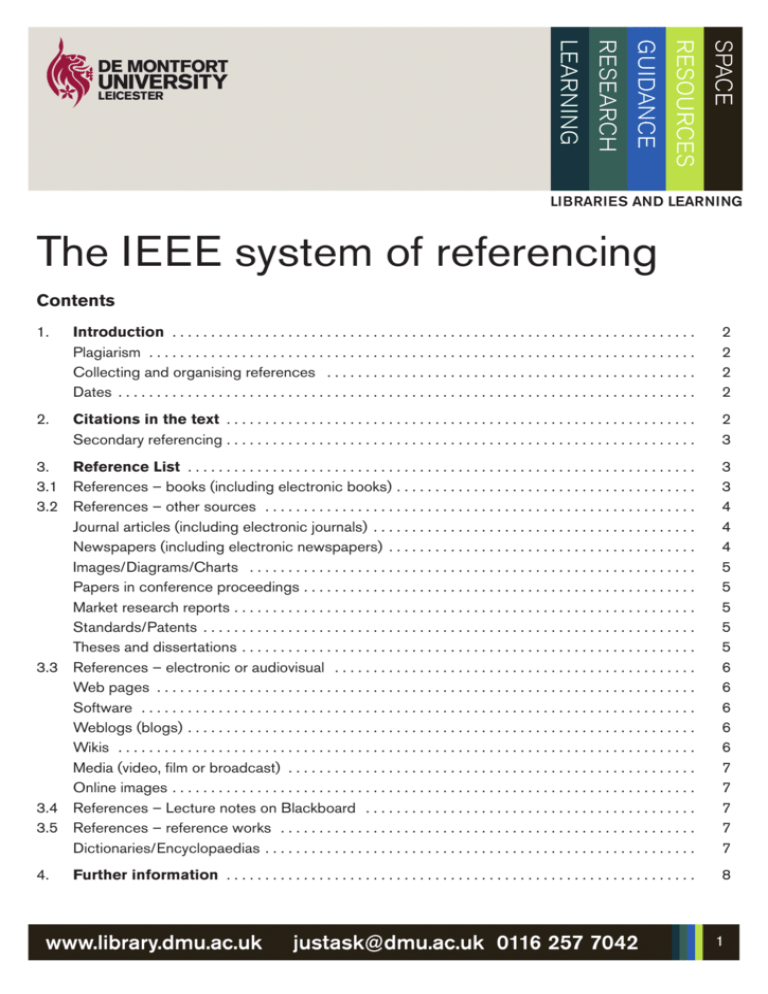
The IEEE system of referencing
Contents
1.
Introduction . . . . . . . . . . . . . . . . . . . . . . . . . . . . . . . . . . . . . . . . . . . . . . . . . . . . . . . . . . . . . . . . . . . .
Plagiarism . . . . . . . . . . . . . . . . . . . . . . . . . . . . . . . . . . . . . . . . . . . . . . . . . . . . . . . . . . . . . . . . . . . . . . .
Collecting and organising references . . . . . . . . . . . . . . . . . . . . . . . . . . . . . . . . . . . . . . . . . . . . . . . .
Dates . . . . . . . . . . . . . . . . . . . . . . . . . . . . . . . . . . . . . . . . . . . . . . . . . . . . . . . . . . . . . . . . . . . . . . . . . . .
2
2
2
2
2.
Citations in the text . . . . . . . . . . . . . . . . . . . . . . . . . . . . . . . . . . . . . . . . . . . . . . . . . . . . . . . . . . . . .
Secondary referencing . . . . . . . . . . . . . . . . . . . . . . . . . . . . . . . . . . . . . . . . . . . . . . . . . . . . . . . . . . . . .
2
3
3.
Reference List . . . . . . . . . . . . . . . . . . . . . . . . . . . . . . . . . . . . . . . . . . . . . . . . . . . . . . . . . . . . . . . . . .
3.1 References – books (including electronic books) . . . . . . . . . . . . . . . . . . . . . . . . . . . . . . . . . . . . . . .
3.2 References – other sources . . . . . . . . . . . . . . . . . . . . . . . . . . . . . . . . . . . . . . . . . . . . . . . . . . . . . . . .
Journal articles (including electronic journals) . . . . . . . . . . . . . . . . . . . . . . . . . . . . . . . . . . . . . . . . . .
Newspapers (including electronic newspapers) . . . . . . . . . . . . . . . . . . . . . . . . . . . . . . . . . . . . . . . .
Images/Diagrams/Charts . . . . . . . . . . . . . . . . . . . . . . . . . . . . . . . . . . . . . . . . . . . . . . . . . . . . . . . . . .
Papers in conference proceedings . . . . . . . . . . . . . . . . . . . . . . . . . . . . . . . . . . . . . . . . . . . . . . . . . . .
Market research reports . . . . . . . . . . . . . . . . . . . . . . . . . . . . . . . . . . . . . . . . . . . . . . . . . . . . . . . . . . . .
Standards/Patents . . . . . . . . . . . . . . . . . . . . . . . . . . . . . . . . . . . . . . . . . . . . . . . . . . . . . . . . . . . . . . . .
Theses and dissertations . . . . . . . . . . . . . . . . . . . . . . . . . . . . . . . . . . . . . . . . . . . . . . . . . . . . . . . . . . .
3.3 References – electronic or audiovisual . . . . . . . . . . . . . . . . . . . . . . . . . . . . . . . . . . . . . . . . . . . . . . .
Web pages . . . . . . . . . . . . . . . . . . . . . . . . . . . . . . . . . . . . . . . . . . . . . . . . . . . . . . . . . . . . . . . . . . . . . .
Software . . . . . . . . . . . . . . . . . . . . . . . . . . . . . . . . . . . . . . . . . . . . . . . . . . . . . . . . . . . . . . . . . . . . . . . .
Weblogs (blogs) . . . . . . . . . . . . . . . . . . . . . . . . . . . . . . . . . . . . . . . . . . . . . . . . . . . . . . . . . . . . . . . . . .
Wikis . . . . . . . . . . . . . . . . . . . . . . . . . . . . . . . . . . . . . . . . . . . . . . . . . . . . . . . . . . . . . . . . . . . . . . . . . . .
Media (video, film or broadcast) . . . . . . . . . . . . . . . . . . . . . . . . . . . . . . . . . . . . . . . . . . . . . . . . . . . . .
Online images . . . . . . . . . . . . . . . . . . . . . . . . . . . . . . . . . . . . . . . . . . . . . . . . . . . . . . . . . . . . . . . . . . . .
3.4 References – Lecture notes on Blackboard . . . . . . . . . . . . . . . . . . . . . . . . . . . . . . . . . . . . . . . . . . .
3.5 References – reference works . . . . . . . . . . . . . . . . . . . . . . . . . . . . . . . . . . . . . . . . . . . . . . . . . . . . . .
Dictionaries/Encyclopaedias . . . . . . . . . . . . . . . . . . . . . . . . . . . . . . . . . . . . . . . . . . . . . . . . . . . . . . . .
3
3
4
4
4
5
5
5
5
5
6
6
6
6
6
7
7
7
7
7
Further information . . . . . . . . . . . . . . . . . . . . . . . . . . . . . . . . . . . . . . . . . . . . . . . . . . . . . . . . . . . . .
8
4.
1
The IEEE system of referencing
This is a guide to the IEEE system but you should always check your course handbook
and/or module outline for any further guidance, as your lecturers may prefer a different
style of referencing. It is always advisable to check which system you are expected to use
and to what extent it may vary from this guide.
1. Introduction
When writing a piece of work you should provide references to the sources used. A reference is the
detailed bibliographic description of the item from which you gained your information. In simple terms, this
means the details of the items that you have used, e.g. author, title, date of publication. References should
be labelled in your text using a number in square brackets [ ]. They are then given in full, in the order that
they have appeared in your work, in a reference list at the end of your work.
Any other items read for background information but not referred to in the text should be given in full at
the end of your work in a bibliography.
Check with your tutor that a Bibliography is required for your work.
References are used to:
•
•
•
•
Enable the reader to locate the sources you have used;
Help support your arguments and provide your work with credibility;
Show the scope and breadth of your research;
Acknowledge the source of an argument or idea. Failure to do so could result in a charge of plagiarism.
Plagiarism
Plagiarism is defined by De Montfort University Student Regulations as “The significant use by a student
of other people’s work and the submission of it as though it were his or her own”. For more information on
how to avoid plagiarism please see www.library.dmu.ac.uk/Images/Howto/HowtoAvoid Plagiarism.pdf
Collecting and organising references
It is often not easy (or possible) to retrieve sources after you have written your text. For this reason it is
best to keep a good record of everything that you use. Reference management software, such as
RefWorks, Mendeley or Zotero, will help you organise your references according to different citation
systems and to add the citations to your text. Alternatively, you could store your references on index
cards. For further information about reference management and help using RefWorks, please see our
reference management guide at: www.library.dmu.ac.uk/Users/Researchers/index.php?page=48.
A note about dates
If no date can be established you can use n.d. in your Reference list.
2. Citations in the text
All ideas taken from another source regardless of whether directly quoted or paraphrased need to be
referenced in the text of your assignment. To link the information you use in your text to its source (book,
article, etc.), put a number in square brackets [ ] at the appropriate point in your text. You should insert the
citation number directly after a source is referred to in your text, even if this is in the middle of a sentence.
e.g. There is some evidence [1] that these figures are incorrect.
2
IEEE style encourages substituting reference numbers for the author’s name wherever possible.
e.g. [1] has provided evidence that these figures are incorrect.
It is acceptable to place a citation number at the end of a paragraph if the entire paragraph is referring to
the same source.
Numbers are sequentially allocated to sources as they appear in the text. However, if referring to a source
that you have already cited the original number is used again.
e.g. There is some evidence [1] that these figures are incorrect. However, [2] suggests an
alternative theory. But on reflection the original evidence [1] has the advantage of a large study.
If you refer to two or more different sources at the same time then the sources are placed in individual
pairs of brackets, separated by commas:
e.g. …this has been discovered in a number of recent studies [3], [10], [14].
Secondary referencing
When an author quotes or cites another author and you wish to cite the original author you should first try
to trace the original item. However, if this is not possible, you must acknowledge both sources in the text,
but only include the item you actually read in your reference list.
e.g. If Jones discusses the work of Smith you could use:
Smith as cited by [1]
or
Smith’s 2009 study cited in [1] shows that…
Then cite [1] (Jones) in full in your reference list.
3. Reference List
Full references of sources used should be listed at the end of your work as a reference list. This list of
references is arranged sequentially in the order that they appeared in your work. Whenever possible,
elements of a reference should be taken from the title page of the publication. Each reference should give
the elements and punctuation as found below.
3.1 References – Books
Books
Author(s), Title of book: subtitle if there is one, Edition – if not the 1st. Place of publication: Publisher,
year of publication.
e.g. N.B. Sterne, Computing in the information age, 2nd ed. New York: Wiley, 1996.
3
For books written by more than one author all authors need to be mentioned.
e.g. M. Ashby, H. Shercliff and D. Cebon, Materials: engineering, science, processing and design,
2nd ed. Oxford: Butterworth-Heinemann, 2010.
Books with one or more editor(s) – Include the abbreviation Ed. or Eds. after their surname.
Editor(s) Ed./Eds., Title, Edition. Place of Publication: Publisher, year of publication.
e.g. J. Kim, Ed., Advances in nanotechnology and the environment. Singapore: Pan Stanford, 2012.
Chapters in books
Author(s), “Title of chapter”, in Editor(s), Ed./Eds., Book title. Edition. Place of publication: Publisher, year
of publication, pages. (use p. or pp.)
e.g. D.S. Davenport and K. Skapple, “Conflict and cooperation over natural resources”, in M.T. Snarr
and D.N. Snarr, Eds., Introducing global issues. London: Lynne Rienner, 2005, pp.277-298.
Note: Electronic books should be cited exactly the same as print, following the rules above.
3.2 References – other sources
Journal articles
Author(s), “Title of article”, Title of journal, volume number, issue number, page numbers, month and year
of publication.
e.g. H. Kilov and I. Sack, “Mechanisms for communication between business and IT experts”,
Computer standards and interfaces, vol. 31, no. 1, pp.98-109, Jan. 2009.
For articles written by more than one author all authors need to be mentioned.
Note: If you are referencing an electronic journal article, use the standard referencing format for
journal articles as detailed above.
Newspaper articles
Author(s), “Title of article”, Newspaper title, Day and Month and Year (abbreviated), page numbers, use
p. or pp. (where there is no page number e.g. an online newspaper use the source).
e.g. J. Gillespie and E. Whalley, “Flight of the robo-bee to save fruit crops”, The Sunday Times,
7th Oct 2012, p.9.
e.g. R. Blakely, “Google creates an artificial mind and all it thinks about is cats…”,
The Sunday Times, 27th June 2012. Available from:
http://www.thetimes.co.uk/tto/technology/article3457388.ece.
4
Images/Diagrams/Charts
Where the image cited from a book is not the work of the author, additional reference to the work should
be made, as follows:
Creator/Artist, “Title of the work”, [Material types, e.g. Image/Diagram/Chart] year, at or in (where found,
for example in a book or museum) Author/editor of book. Title. Place of publication: Publisher, year, page
number.
e.g. W.R. Stahel, “The Self-Replenishing System”, [Diagram] 1982, in P. Stasinopoulos, M.H.
Smith, K. Hargrovers and C. Desha, Whole system design: an integrated approach to
sustainable engineering. USA: Earthscan, 2009, p.91.
Papers in conference proceedings
Author(s), “Title of paper”, in Title of the conference proceedings, place and date of conference (unless
included in title), pages, use p. or pp.
e.g. W. Al-Azzawi and M. Al-Akaidi, “Robust stability of solar-power wireless network control
system with stochastic time delays based on H2 norm”, in IET Conference on wireless sensor
systems (WSS 2012), June 2012, pp.1-6.
Market research reports
Name of issuing body, Title, Edition (if available). Place of publication: Publisher, Report no. (if relevant),
date.
e.g. Mintel, Mobile application gaming: Mintel marketing report. London: Mintel International,
February 2012.
Standards/Patents
Name of the organization/Author that has produced the standard/patent, Title of the standard/patent,
number of the standard/patent, date.
e.g. British Standards Institute, Reciprocating internal combustion engines. Exhaust emission
measurement. Measurement of gaseous and particulate exhaust emissions under field
conditions, BS ISO 8178-2, 2008.
Theses and dissertations
Author, Title, Designation (Level, e.g. MSc., PhD.), Institution, Year.
e.g. H. Sasse, Enhancing numerical modelling efficiency for electromagnetic simulation of physical
layer components, PhD., De Montfort University, 2010.
5
3.3
References – Electronic or audiovisual
Web pages
The nature of web resources means that author names are often not available and dates can be very
vague. Therefore you will need to decide who is responsible for producing the web page and use them as
the author, often this will be an organization rather than a personal name. You should be able to find this
information by following “about us” or “contact us” links. If there is no author, or organization you can use
the title of the web page, if there is no title use a truncated web address (you should consider whether
this resource is suitable for academic work).
Author(s), Title of document, Organization/publisher, year. [Online] Available from: web address
[Accessed date].
e.g. Institution of Mechanical Engineers, Energy and buildings: energy policy statement 09/05,
Institution of Mechanical Engineers, 2013. [Online] Available from:
http://www.imeche.org/knowledge/policy/energy/policy/energy-and-buildings
[Accessed 13/05/13].
If you are referencing an electronic journal article, newspaper article or book, use the standard
referencing format for that item. Guidelines can be found above.
Note: Dates are not always available for web pages, if this is the case use n.d. where n.d. represents no
date so that the reader knows you have omitted this element.
e.g. AI Horizon, Introduction to the problems of Go AI programming, AI Horizon, n.d. [Online]
Available from: http://www.aihorizon.com/essays/goai/intro.htm [Accessed 13/05/13].
Software
Individual authors are rarely acknowledged. If you cannot find a named author of an electronic source then
use the organization or title in place of the author.
Author or Originator, Title, [Software] version/series etc. Place of publication: Publisher, year.
e.g. SPSS, SPSS for Windows, [Software] version 12.0.1. Chicago: SPSS, 2004.
Weblogs (Blogs)
Author, “Title of the posting” (if applicable), Title of the site. [Online] day/month/year of posting.
Available from: web address [Accessed date].
e.g. W. Osama, “DHCP client testing tool”, Networkers online. [Online] 26th April 2013.
Available from http://www.networkers-online.com/blog/ [Accessed 17/05/13].
Wikis
Wiki name, Title of article, [Online] year. Available from: web address [Accessed date].
e.g. Rapid prototyping, Reprap, [Online] 2009. Available from:
http://rapidprototyping.wikidot.com/reprep [Accessed 24/05/13].
6
Media (video, film, or broadcast)
Title, Type of media, Originator (e.g. director). Place of production: Production company, year.
e.g. Avatar, Film, directed by James Cameron. USA: Warner Bros, 2010.
A television or radio broadcast should also include the date and time of broadcast and the episode
number, where possible.
Title, Type of media, Originator (e.g. channel). Exact date and time of broadcast.
e.g. Plastic: how it works, TV, BBC4. 10th September 2012, 1930 hrs.
Online Images
Originator, Description or title of image [Online image], year. Available from: web address [Accessed date].
e.g. Electrical Engineering Portal, Electrical engineering books and guides [Online image], 2013.
Available from: http://electrical-engineering-portal.com/download-center/books-and-guides
[Accessed 1/7/2013].
3.4 References – Lecture notes on Blackboard
Lecturer(s), “Lecture title”, from module code (capitalised) title of module. Teaching organisation, location
and date of presentation. Available from Blackboard [Accessed date].
e.g. S. Linfoot, J. Gow, and P. Prickett, “Introductory Lecture”, from ENGD1008 Principles of
design and manufacture. De Montfort University, Queens Building on 11th October 2012.
Available from Blackboard [Accessed 3/7/13].
3.5 References – Reference Works
Dictionaries/Encyclopaedias
If an encyclopaedia entry has a named author then the format for a chapter in a book should be used with
the addition of the encyclopaedia volume number.
Author(s), “Title of chapter”, in Author(s)/Editor(s), Title. Volume (if applicable), Edition. Place of
publication: Publisher, year, Pages. (use p. or pp.)
e.g. R.P. Kesner, “Memory neurobiology”, in V.S. Ramachandran, Encyclopedia of the human brain.
Vol. 2, San Diego: Academic Press, pp. 783-796.
7
If there is no author then the title (e.g. Oxford English Dictionary) should be used in the reference list.
Title, Volume (if applicable), Edition. Place of publication: Publisher, year.
e.g. The Oxford English Dictionary, Vol. 3. Oxford: Clarendon Press, 1989.
Note: If you are referencing from an online source use the standard referencing format for
reference works as detailed above.
4. Further Information
If you need further help please contact your subject librarian, tech-library-enquiries@dmu.ac.uk or
justask@dmu.ac.uk.
© DMU Library & Learning Services. All rights reserved. Publication No. 23092
Issued: 10/14
PC1989
8

